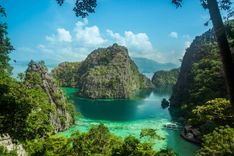Is the Philippines a good destination for families?
Yes – if your family likes beaches, boat rides, and spontaneous karaoke, the Philippines can be a great choice. It’s not Disney-level organized, but it’s warm, welcoming, and full of adventure. Just be ready for heat, unpredictable transport, and the occasional power cut.
The vibe is family-first across the country – kids are doted on, locals will chat with them everywhere, and no one will blink if your toddler’s melting down in public. Just plan with some flexibility and patience – these family-focused Philippines travel tips will help you make the most of it.
Where to go with kids in the Philippines
Cebu hits the sweet spot between beach and city. You’ll find child-friendly resorts, waterfall treks like Kawasan Falls, and snorkel spots where even beginners can spot clownfish. Island-hopping to nearby Bohol adds tarsier sanctuaries and chocolate hills to the mix.
Palawan is an obvious draw, especially El Nido and Coron. Boat tours, clear lagoons, and chill beach days are kid-friendly, but younger kids might struggle with long boat rides or rough sea days – go when it’s calm (dry season) and book private tours if you can.
Boracay is back in business, cleaner and more family-friendly than before. Calm waters, soft sand, and a walkable beachfront make it a safe bet for little ones. Bigger resorts have pools, kids’ clubs, and babysitters.
Baguio or Sagada in the mountains are cooler escapes from the heat, with scenic hikes, caves, and fresh strawberries. Just beware of winding roads – motion sickness is real.
Manila is chaotic, but it has kid-friendly museums, air-conditioned malls with play areas, and historical sights like Intramuros and Rizal Park. It’s best as a stopover, not a base.
Getting around and where to stay
When it comes to getting around the Philippines, don’t expect stroller-friendly sidewalks or seamless connections. Strollers and Philippine sidewalks don’t mix – baby carriers are more useful, especially in crowded cities or rural towns with uneven paths. Most public transport isn’t stroller-accessible, and buses or jeepneys won’t wait for you to fold one up.
Taxis and Grab (the local ride app) are the most convenient options in cities. Just note that car seats are rare, so bring your own if safety’s a priority.
Flying between islands saves time, and domestic flights are frequent, but delays aren’t uncommon, so leave room in your schedule. Ferries are the budget alternative, but they’re slower and can be rough – less ideal if your kids get seasick or restless.
Hotels run the gamut from basic inns to full-on resort mode. Family rooms and triple-sharing setups are common, though not always advertised clearly – check directly if you need cots or extra beds. Bigger resorts usually come with pools, breakfast buffets, and enough space for kids to burn off steam.
Food, supplies, and eating out with kids
Filipino food is easygoing and often kid-approved – fried chicken, rice, noodles, BBQ skewers, and tropical fruits are hits with picky eaters. Portions are generous and locals are used to sharing meals.
You’ll find diapers, wipes, and formula in supermarkets and pharmacies in cities. Rural areas? Bring your own. Local snacks (banana chips, dried mango, skyflakes) make great travel bribes.
Public bathrooms can be basic. No changing tables, so bring a mat and hand sanitizer.
Safety and health tips for families
The Philippines is generally safe, but some travel-with-kids basics apply:
- Heat and humidity are relentless – hydrate constantly and take AC breaks.
- Sunscreen is expensive locally – bring your own.
- Mosquitoes love tropical evenings. Use repellent, especially near water or rice fields.
- Tap water isn’t drinkable. Stick to bottled for drinking and brushing teeth.
- Traffic is unpredictable – hold hands and cross carefully, even at marked crossings.
Medical care is decent in big cities – St. Luke’s and The Medical City in Manila are reliable. In smaller towns, expect limited equipment and long waits. Pharmacies are everywhere, and staff usually speak English.













